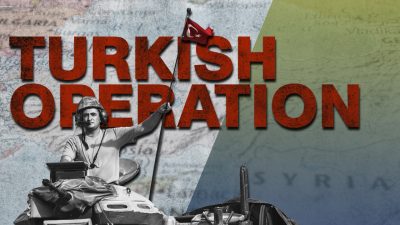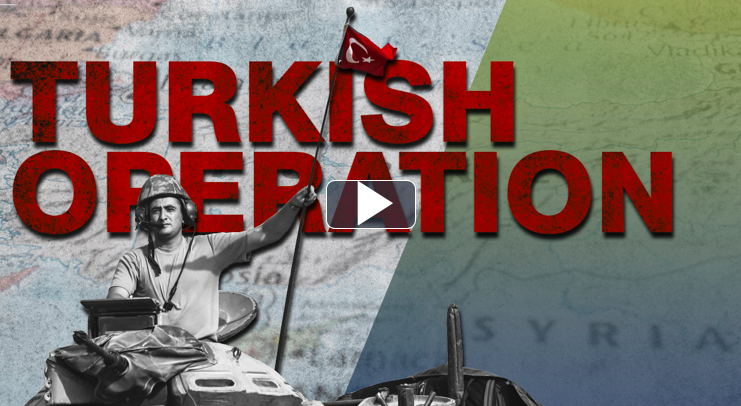Video: Turkey’s “Operation Peace Spring”. US Withdraws. Turkey Invades Northeastern Syria. Bombs US Supported YPG Forces

Turkey officially announced that it had launched a military operation in northeastern Syria. Over the past years, Turkish President Recep Tayyip Erdogan and other representatives of the country’s leadership have repeatedly announced this idea. However, this time promises were turned into reality.
On October 6, the administration of US President Donald Trump released a statement saying that Turkey will soon carry out its “long-planned operation” into northern Syria. According to the statement, US forces will not “support or be involved in the operation” and “will no longer be in the immediate area”. The announcement came following a phone conversation between the US and Turkish presidents.
On October 7, US forces started withdrawing from their positions along a large chunk of the Syrian-Turkish border. US military garrisons in Tel Abyad, Tel Musa, Tel Hinzir and Tel Arqam were abandoned. US patrols in the border area were halted. The Pentagon provided no details regarding the number of troops withdrawn from the border. US mainstream media outlets mention the numbers from 50 to 100.
This US decision caused a kind of panic among leaders and members of the Syrian Democratic Forces (SDF). They simultaneously called the US decision a backstab, asked the US-led coalition to establish a no-fly zone ‘like in Iraq’ and declared their readiness to resume negotiations with Russia and the Assad government, which they just a few weeks ago were calling a ‘bloody regime’.
Kurdish armed groups, mainly the People’s Protection Units (YPG) and the Women’s Protection Units (YPJ), are the core of the SDF. The Kurdish Democratic Union Party (PYD) dominates in the self-proclaimed administration of northeastern Syria. Ankara names the YPG, the YPJ and the PYD terrorist groups because of their links to the Kurdistan Workers’ Party (PKK). This separatist group is engaged in a long-standing guerrilla war against the Turkish state in an attempt to establish an independent Kurdish state on territory of southeastern Turkey. The PYD and its military wings pursue similar goals in northeastern Syria.
Ankara has reasonable concerns that funds, weapons, equipment and training provided by the US to Kurdish armed groups in northern Syria will later be used by the PKK in its fight against the Turkish government. The US-Turkish ‘safe zone’ agreement on northern Syria was designed to remove these concerns. Turkey insisted that Kurdish armed groups should be removed from the border and disarmed, or, at least, the US should stop supplying them with weapons and equipment. However, this did not happen. The peak of the US-Turkish coordination over this question was several joint patrols along the border.
By evening of October 9, Turkey had put its proxy forces on a high alert and the Turkish Air Force had bombed SDF positions near Tell Abyad, Ras al-Ayn, Kobane and al-Qamishli. The Operation Peace Spring started.
President Erdogan says that its goals are to neutralize “terror threats” along the border, establish a real safe zone and facilitate return of Syrian refugees to their homes. Besides the anti-terror declarations, one of the main points of the Turkish public rhetoric is the oppression of Arab locals by Kurdish militias.
If the Operation Peace Spring develops like Turkish operations in al-Bab and Afrin, Ankara will use its proxy groups as a first line of the ground advance and a shield for Turkish personnel deployed on the ground. Artillery, warplanes and special forces of the Turkish military will be the main striking power. Pro-Turkish sources say that about 15,000-20,000 members of pro-Turkish groups have already been mobilized. If this is true, the total number of personnel, including Turkish servicemembers, involved in the operation may reach 30,000.
At the first phase of the advance, Turkey will likely to get control of the area of the non-implemented US-Turkish safe zone. Some Turkish sources speculate that in the event of success the Turkish Army may push even towards Deir Ezzor. However, this remains unlikely in the current military and diplomatic situation in the region.
*
Note to readers: please click the share buttons above or below. Forward this article to your email lists. Crosspost on your blog site, internet forums. etc.
We call upon Global Research readers to support South Front in its endeavors.
If you’re able, and if you like our content and approach, please support the project. Our work wouldn’t be possible without your help: PayPal: [email protected] or via: http://southfront.org/donate/ or via: https://www.patreon.com/southfront


